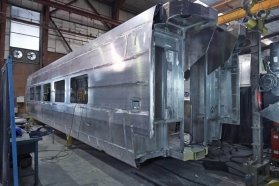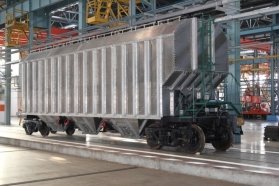The article describes the advantages of using aluminum alloys for manufacturing rolling stock in railway transportation. It presents the prospects of applying a new aluminum deformable alloy 1580, which is based on the aluminum-magnesium system with scandium addition, in the production of railway cars. The technology for producing sheets from this alloy was jointly developed by the Russian company RUSAL and scientists from Siberian Federal University.
Keywords: railway transportation, aluminum alloys, wagons, magnalium, corrosion resistance.
Introduction
The cost-effectiveness of railway transportation is determined by several factors, with the main ones being train speed, energy consumption, and rail load. In recent times, there has been active implementation of aluminum alloys in various constructions of both freight and passenger railway cars, replacing steel. This can be attributed to the numerous advantages that aluminum alloys offer compared to steels [1–5].
- The density of aluminum alloys is nearly three times lower than that of steel, resulting in a lower tare coefficient for aluminum alloy cars. The tare coefficient is calculated as the ratio of the car's weight to its payload capacity. Therefore, for longer freight routes, the use of aluminum alloy cars becomes more advantageous, particularly for countries with extensive railway networks.
- The environmental friendliness of aluminum alloys and their recyclability enable significant energy savings compared to black metals obtained through ore processing. The manufacturing technologies of semi-finished products from aluminum alloys also help reduce harmful emissions in the face of stricter environmental legislation.
- The corrosion resistance of aluminum alloys increases the durability of car operation and eliminates the need for painting.
- Aluminum alloys exhibit high technological versatility in casting and various types of metal processing under pressure, such as rolling, pressing, drawing, and stamping.
Utilization of aluminum alloys The aforementioned advantages imply that although the initial cost of aluminum alloy cars is higher than steel ones, this difference is compensated during their operation, approximately within a two-year period, due to the transportation of a larger volume of cargo. Furthermore, aluminum cars, unlike steel ones, have a longer lifespan as they are not susceptible to corrosion. As demonstrated by practice, such cars only lose 10 % of their value over 40 years of use.
These factors have led many countries to actively transition to manufacturing freight cars from aluminum alloys, such as hopper cars (self-unloading bulk cargo cars), tank containers, tanks, and others. These cars are characterized by durability, reduced weight, increased payload capacity, and the absence of the need for painting. Figure 1 shows some types of car designs made of aluminum alloys.


Fig. 1. Designs of freight cars made of aluminum alloys
The use of aluminum in passenger railway transportation allows for a weight reduction of approximately 30 % in the carriages. This is particularly beneficial for metro systems and suburban electric trains that frequently make stops, as it leads to significant energy savings during the periodic acceleration of the train. Additionally, aluminum carriages are easier to manufacture and their construction involves fewer components.
In the production of high-speed trains, which can reach speeds of up to 600 km/h or more, lightweight aluminum alloys reduce the train's weight, thereby reducing rail deflection and the resulting resistance to movement. Similar to aircraft, such trains must have a streamlined shape with minimal protruding parts, and in such cases, designers draw from the experience of aerospace engineers. An example of a high-speed train is the Afrosiyob train, which operates regular trips on the Tashkent-Bukhara route, with carriages made of aluminum alloy (Figure 2).

Fig. 2. High-speed train Afrosiyob
The feasibility of using aluminum alloys in railway transportation is supported by Russian state standards [6–10].
In the production of structures for railway transportation, aluminum alloys of the 5xxx and 6xxx series are primarily utilized [11–13]. The 5xxx series alloys, belonging to the Al-Mg (magnesium) system, are distinguished by high corrosion resistance and excellent weldability [14–16], combined with moderate strength properties. They are classified as non-heat-treatable alloys and are predominantly employed in the form of components manufactured from sheet semi-finished products. The 6xxx series alloys of the Al-Mg-Si system possess higher strength characteristics and are typically used in the form of extruded profiles.
New Aluminum Alloys In terms of expanding the prospects of using aluminum alloys in railway transportation, the greatest interest lies in the new alloys of the Al-Mg system with rare earth element (REE) additives, which allows for a significant enhancement of the strength properties of magnesium alloys while maintaining a high level of ductility through the preservation of a non-recrystallized structure after deformation and annealing [4–6]. The range of magnesium alloys already used for railway cars is expected to be expanded with the introduction of alloy 1580, developed by the company «OK RUSAL» in collaboration with scientists from Siberian Federal University (SFU).
This alloy exhibits a high level of weldability and weld joint strength compared to its closest counterparts [3–5]. Although semi-finished products made from this alloy are more expensive due to the presence of costly scandium, the strength characteristics it possesses allow for the production of semi-finished products with thinner walls. This, in turn, helps to balance the production costs of the structure and significantly reduce its weight.
Furthermore, active efforts are currently underway to reduce the amount of scandium in this alloy by incorporating rare earth metals, particularly zirconium. This prospective development will lower the cost of the alloy and, consequently, decrease the cost of the semi-finished products that can be utilized in the manufacturing of rolling stock.
Aluminum alloy grade 1580 has already found practical application in the maritime industry and is actively competing with other aluminum alloys. Experimental tests demonstrate its high level of strength characteristics, which opens up prospects for using this alloy in the production of structures and components for railway transportation alongside other aluminum alloys.
A comprehensive set of research activities has been conducted at SFU to develop the technology for producing sheet semi-finished products from alloy 1580. During these investigations, the microstructure and fine structure of the alloy were examined at all stages of processing. Additionally, computer and physical modeling of the entire sheet production process were carried out, starting from semi-continuous casting of slabs to hot and cold rolling. The ProCAST program was utilized for casting simulation on a laboratory semi-continuous casting setup, while hot and cold rolling modeling was performed using the DEFORM software. Following computer modeling, the results were validated through physical modeling using SFU laboratory equipment. It is important to note that the casting and rolling parameters obtained through the modeling process were successfully tested at a Russian metallurgical plant for the production of large-sized slabs. Industrial batches of sheets made from alloy 1580 were rolled and their performance properties, such as weldability, formability during sheet stamping, corrosion resistance, among others, were subsequently studied [12–16].
The work was carried out as part of the state research assignment of the Federal State Autonomous Educational Institution of Higher Education «Siberian Federal University» project number FSRZ-2021–0010.
References:
- Yu.P. Boronenko. Method of assessing the energy efficiency of freight wagons. Transport of the Russian Federation. 3 (100), 37–39 (2022).
- Yu.P. Boronenko. B. O. Polyakov, I. R. Kron, R. V. Rakhimov and Ya.O. Ruzmetov Determination of energy efficiency of freight wagons. Transport of the Russian Federation. 8, 39–45 (2022).
- I. R. Kron and B. O. Polyakov Computational and experimental method for determining the basic resistance to movement of rolling stock using digital models. Transport of the Russian Federation. 4 (95), 50–53 (2021).
- A.A. Aksenov, Y.N. Mansurov, D.O. Ivanov, R.K Shuvatkin and E. D. Kim. Mechanical Alloying of Secondary Raw Material for Foam Aluminum Production. Metallurgist. 61(5–6), 475–484 (2017).
- M. V. Khudorozhko. Improving the efficiency of using an electric locomotive with a microprocessor control system by promptly clarifying the thermal parameters of the traction electric motor and the resistance to train movement. Transport of the Russian Federation. 22, 25–37 (2009).
- Yu.P. Boronenko, B. O. Polyakov, I. R. Kron and T. M. Belgorodtseva. Computational and experimental method of determination energy efficiency of freight wagons using digital models. Transport of the Russian Federation. 2. 41–43 (2022).
- I. R. Kron and Yu.P. Boronenko. Energy efficiency of freight wagons and a new method for determining their main resistance to movement. Transport: problems, ideas, prospects: Proceedings of the LXXXII All-Russian Scientific and Technical Conference of Students, Postgraduates and Young Scientists. 8, 29–34 (2022).
- A. V. Klimovich, A. A. Koobar and A. S. Lendyasov. Methodology for determining the resistance to train movement in a completed trip according to the data of the electronic motion parameter recorder. Izvestiya Transsib. 3 (3), 16–25 (2010).

